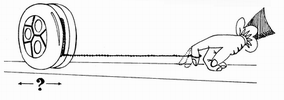ANU
Chapter 2 A New Approach to Calculations in the Quantum Field Theory of Charged particles opens as follows:
The calculations we perform in subsequent chapters comprise the first exposition of quantum electrodynamics that does not involve the concept of renormalisation and yet does not reject graph theory. Two principles guide us:
Principle A asserts the validity of the dispersion relations appropriate to the quantities to be calculated, some of these DR being well known, others postulated by us for the first time. This principle is used to help us ascertain the graph elements for new theories as well as providing our basic computational device.
Principle B asserts the correctness of the well-known graph elements for Dirac spin 1/2, scalar spin zero, and 5x5 β spin zero, and prescribes that as much of Lagrangian formalism and Dyson-Wick procedures as seem substantive be utilised to determine the graph elements for previously unconsidered theories.
Published Papers on Theoretical and Mathematical Physics
H. A. Cohen,
Covariant Wave Equations for Charged Particles
of Higher Spin in an Arbitrary Gravitational Field,
Il Nuovo Cimento, Serie X, Vol 52A, 1967 pp 1242-1253
1967
H. A. Cohen* and J. Smith**,
The C-Conserving Decay Modes η → π0e+e- and
η → π0μ+μ- H. A. Cohen,
Vacuum polarization in the Lee and Yang theory of charged spin one
,
Il Nuovo Cimento A Series 10
21 Luglio 1968, Volume 56, Issue 2, pp 467-478
Summary:
The radiative correction, to ordere 2, to the photon propagator in the Lee and Yang theory of charged spin-one bosons, is calculated in a dispersion-theoretic manner.
Some general aspects of the ξ-limiting formalism are
discussed. A useful matrix treatment of Lorentz tensors is
presented in an Appendix.
1969 A.J. Bracken and H. A. Cohen,
Five Classes of Transformations of Dirac Spinors
� The Free-Particle Dirac Equation Is Brought to �p0-, �p1-, �p2-, �p3- and �m-Linear� Forms �,
Progress of Theoretical Physics, Vol 26, No 1, 1969, pp 816-831.
1969 A.J. Bracken and H. A. Cohen,
On Canonical SO(4,1) Transformations of the Dirac Equation,
Journal of Mathematical Physics, Vol 10, No 11, Nov. 1969, pp 2024.
Abstract: Certain matrix transformations of the free-particle Dirac equation are described
as momentum dependemt SO(4,1) transformations. Such of these belonging to any one of five subgroups
G(α)(α=0,1,2,3,4,5) are canonical, preserving the Lorentz-invariant product
in a corresponding one of five modes of expression. The Dirac equation itself is linear
in all five components pα[pμ(μ=0,1,2,3) is the
four-momentum operator, p4=m ] of the "five-vector" p~,
and a transformation in G(β) has the additional property
that the component pβ appears linearly also in the transformed equation.
The Mendlowitz and the Foldy-Wouthuysen-Tani accordingly are in G(0),
the SO(4) subgroup; and that proposed by Chakrabarti is in G(4),
the SO(3,1) subgroup associated with homogeneous Lorentz transformations.
For any p~` obtained from p~ by a momentum-dependent
Lorentz transformation, there is a corresponding transform of the Dirac equation.
Where pα appears in the transformed equation, p`α appears in the transformed equation.
The ambiguities which arise in the specification of the transform leading to a given
such equation are associated with the existence of a "little group" for any such p~`.
1971 H. A. Cohen,
On the Derivation of the Pryce-Foldy-Wouthuysen transformation,
American Journal of Physics,
Vol 39, April 1971, pp 409-412.
1972 H. A. Cohen,
On Time Non-Special Quantum Mechanics, Acta Physica Austrica, Suppl. IX, 1972
pp 851-855.
1973.1 E.F. Carter and H. A. Cohen,
The Classical Problem of Charge and Pole, American Journal of Physics, Vol 41, Issue 8, Aug 1973, pp 944-950.
1973.2 H. A. Cohen, On the Dirac Monopole Potential,
Prog. Theor. Phys. Vol. 50 No. 2 (1973) pp. 691-696 1974 H. A. Cohen and M.Z. Shaharir The Action Principle
in Quantum Mechanics,
International Journal of Theoretical Physics, Vol. 11 No. 5 (1974) pp. 289-303 H. A. Cohen, Is There a
Quantization Condition for the Classical
Problem of Charge and Pole,
Foundations of Physics, Vol. 4 No. 1 (1974) pp. 115-120
Summary It is known that special difficulties are encountered in devising a wave equation to describe higher spin S≥3/2
particles in interaction with the electromagnetic field,
and Buchdahl has shown that like
difficulties arise when the gravitational field is introduced. We show
that just as a consistent electromagnetic interaction can be introduced,
so wave equations describing charged particles of spin S = 3/2 and of spin S = 2 in a universe endowed with a Riemannian metric can be devised.
The paper incorporates an account of Dirac γ matrices in general relativity.
RIASSUNTO (*)
� noto che sorgono pa ri ieolari difficolt� quando si vuole impostare un'equazione d'onda che descriva particelle di spin superiore o uguale a interagenti con un campo elettromagnetico, e Buchdahl ha mostrato come simili difficolt� sorgano anche quando si introduce un campo gravitazionale. In questo articolo si fa vedere che come si pu� introdurre una interazione elettromagnetica coerente, cos� si possano trovare equazioni d'onda descriventi particelle cariche di spin S 2 o S= 2 in un universo dotato di metrica Riemanniana. Nell'articolo si includono considerazioni sulle matrici y di Dirac in relativit� generale.
(*) Traduzione a cura della Redazione.
![]()

The most recent citation of this 1967 publication is this paper on the arXiv preprint registry:
[General Relativity and Quantum Cosmology] submitted Wed, 2 Aug 2017.
Harold Erbin, Vincent Lahoche, Universality of tunnelling particles in Hawking radiation
https://arxiv.org/pdf/1708.00661.pdf [gr-qc]
![]()
* Mathematical Physics, University of Adelaide
** Institute for Theoretical Physics, State University of New York at Stony Brook
The C-conserving decay rate for η → π0μ+μ-
is of second order in the fine structure constant. A knowlege of the matrix elements
η →γγ and γγ → e+e-
is sufficient to find the imaginary part of the matrix element
η → π0μ+μ-
from unitarity. The real part of the matrix element can be found from dispersion relations.
Recent theoretical estimates (1) of the decay rate for
η → π0e+e-
have assumed an interaction
ηπ0FμνFμν
for the
ηπ0γγ amplitude.(2)
However, this interaction leads to the result that the decay rate into one π0
is proportional to the square of the mass of the leptons. The rate is therefore much larger for muons(3)
than for electrons, whereas the contrary conclusion is reached using the simple phase space argument. (which supposes
a constant matrix element).
One way to modify this result is to note that the C-conserving decay amplitude is
decomposible into two invariant amplitudes:
the first corresponding precisely to the S-wave interaction given above and the second
to the P-wave interaction included in
ηπ0PαPβFαμFβμ
where P is the η four momentum. In this paper we
adopt the second interaction leading to a calculation that is parallel
to the calculation(3) by the second author
based on the first interaction. We calculate both the
η → π0e+e- and
η → π0μ+μ-
decay rates
-->
Riassunto
Calcoliamo, servendoci della teoria della dispersione,
la correzione radiativa, di ordinee 2, al propagatore
fotonico nella teoria di Lee ed Yang dei bosoni di spin
uno carichi. Si discutono alcuni aspetti generali del
formalismo ξ-limitante. In un appendice si presenta un
utile trattamento matriciale dei tensori di Lorentz.
HINDSIGHT: The Dyson-Wick formalism that produced a manageable theory of elementary
charged particles of spin 1/2 and zero spin simply failed to handle spin one QED.
Lee and Yang attempted to develop a quantum electrodynamics of charged spin one
by introducing a ξ-limiting formalism. Although no actual
values were determined for this most speculative spin-1 QED, Lee and Yang proclaimed that their novel theory worked.
In this paper I showed that using the Cutkosky approach to finding the (finite)
discontinuities across the branch cuts in the complex momentum plane
for substitution in the relevant dispersion relation.
Contrary to Lee and Yang's claims of adequacy -- these integrals -- unlike those for spin zero and spin 1/2,
simply diverged and the ξ-limiting process did not remove the infinities.
![]()
Abstract:
The free-particle Dirac equation has two remarkable features: (1) It
is linear in all four components of the energy-momentum pμ, and also in the mass m.
(2) For its solutions there are five distinct simple modes of the invariant scalar product
in the momentum representation. In this paper, a theorem presented by Case is generalized
and used to obtain five classes of transformations of the Dirac equation. Every transformation in a given class has two properties characteristic of the class: (1) The linearity in a corresponding one of the five quantities p�, m is maintained in the transformed equation. (In this way ``p_0-, ``p_1-, ``p_2-, ``p_3- and ``m-linear'' forms of the Dirac equation are obtained.) (2) A corresponding mode of the invariant scalar product is presented. Thus all five classes consist of canonical transformations. Included amongst the ``p_0-linear'' forms are the Foldy-Wouthuysen-Tani equation, and the one commonly attributed to Cini and Touschek, together with equations appropriate to limiting situations other than the non-relativistic and extreme relativistic ones. The ``canonical'' form proposed by Chakrabarti is of the ``m-linear'' type.
Belonging to all three of the ``p1-, ``p2- and ``p3-linear'' categories is a
``p-linear'' form of significance for large |p|.
![]()
Abstract: A simple and instructive derivation of the Pryce-Foldy-Wouthuysen transformation
is given in terms of rotations in two dimensions.
Abstract: A reformulation of quantum mechanics is described
in which the z co-ordinate is described in which the z co-ordinate has the special role with
regard to the three other space-time co-ordinates that the time t
has in the usual formulation.
![]()
Abstract: In this paper the classical dynamics of interacting electrically charged particles
where one or both possess magnetic charge is reviewed. The equations of motion are
obtained, and the vector constants of motion are derived. A consistent canonical
formalism is developed while related aspects such as scale
invariance and the geometry of the motion are also discussed.
![]()
Abstract:
The Grönblom-Jordan picture of the Dirac magnetic monopole is reviewed.
The role of the string in a single-valued vector potential describing a magnetic
monopole is demonstrated. First Page Only
Abstract:
The Euler-Lagrange equation derived from Schwinger's action
principle (1951) has been shown by Kianget al. (1969) and
Linet al. (1970) to lead to inconsistencies for quadratic
lagrangians of the form
 except in the Euclidean case gjk =δjk .
This inadequacy is linked to Schwinger's specification that the variations of
operators be c-numbers. We reformulate the action principle by introducing the concept
of ‘proper’ Gauteaux variation of operators to find the most general class of
admissible variation consistent with the postulated quantisation rules.
This new action principle, applied to the LagrangianL, yields a quantum Euler
equation consistent with the Hamilton-Heisenberg equations.
except in the Euclidean case gjk =δjk .
This inadequacy is linked to Schwinger's specification that the variations of
operators be c-numbers. We reformulate the action principle by introducing the concept
of ‘proper’ Gauteaux variation of operators to find the most general class of
admissible variation consistent with the postulated quantisation rules.
This new action principle, applied to the LagrangianL, yields a quantum Euler
equation consistent with the Hamilton-Heisenberg equations.
Abstract: In elementary derivations of the quantization of azimuthal angular momentum
the eigenfunction is determined to be exp(imφ), which is "oversensitive" to the rotation
φ → φ +2π, unless m is an integer. In a recent paper Kerner examined
the classical system of charge and magnetic pole and expressed Π,
a vector constant of motion for the system, in terms of a physical
angle ψ,
to deduce a remarkable paradox. Kerner pointed out that
Π(ψ)
is "oversensitive"
to ψ → ψ +2π, unless a certain charge quantization
condition is met. Our
explicandum of this paradox highlights the distinction
between coordinates in classical and quantum physics.
It is shown why the single-valuedness requirement on Π(ψ)
is devoid of physical significance.
We are finally led to examine the classical analog
of the quantum mechanical argument
that demonstrates the quantization of magnetic charge,
to show that there is "no hope" of
a classical quantization condition.

